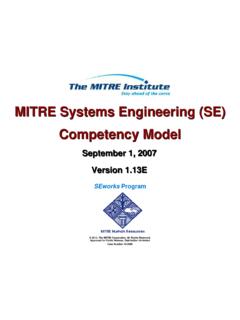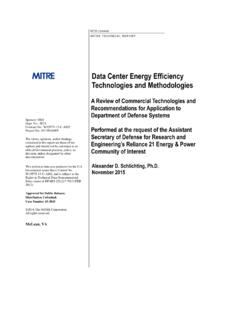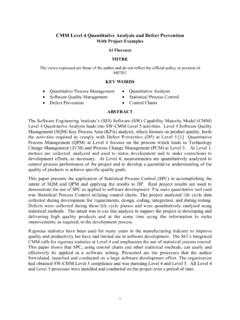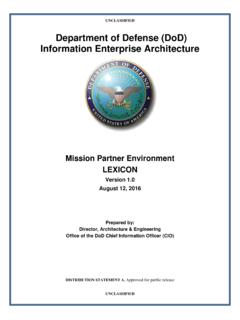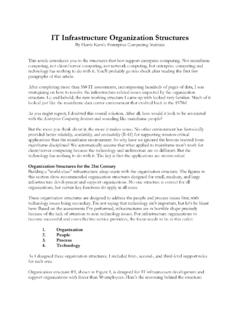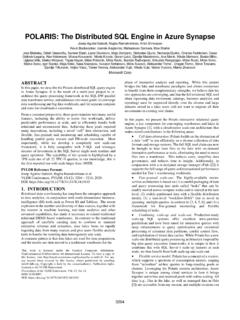Transcription of Guide for Creating Useful Solution Architectures
1 Prepared for Department of Homeland Security Guide for Creating Useful Solution Architectures Core Research Program, Keys for Successful Deployment of IT Solution Architecture December 4, 2017 Version Approved for Public Release; Distribution Unlimited. Case Number 17-4589 / DHS reference number 16-J-00097-02 This document is a product of the Homeland Security Systems Engineering and Development Institute (HSSEDI ). ii Homeland Security Systems Engineering & Development Institute The Homeland Security Systems Engineering & Development Institute (HSSEDI) is a federally funded research and development center (FFRDC) established by the Secretary of Homeland Security under Section 305 of the Homeland Security Act of 2002.
2 The MITRE Corporation operates HSSEDI under the Department of Homeland Security (DHS) contract number HSHQDC-14-D-00006. HSSEDI s mission is to assist the Secretary of Homeland Security, the Under Secretary for Science and Technology, and the DHS operating elements in addressing national homeland security system development issues where technical and systems engineering expertise is required. HSSEDI also consults with other government agencies, nongovernmental organizations, institutions of higher education, and nonprofit organizations. HSSEDI delivers independent and objective analyses and advice to support systems development, decision making, alternative approaches, and new insight into significant acquisition issues.
3 HSSEDI s research is undertaken by mutual consent with DHS and is organized by tasks. The research performed for this this report is conducted under Task Research Execution Plan (TREP) number - TREP102, P16-64: Core Research Program, Key for Successful Deployment of IT Solution Architectures . This document provides DHS Information Technology (IT) Solution Architects, Program Managers, and Systems Engineers with a practical Guide for Creating Useful Solution Architectures . The document leverages best practices research and addresses key challenges to Solution Architecture at DHS, previously developed by HSSEDI. The information presented in this report does not necessarily reflect official DHS opinion or policy.
4 For more information about this publication contact: Homeland Security Systems Engineering & Development Institute The MITRE Corporation 7515 Colshire Drive McLean, VA 22102 Email: iii Acknowledgements The Homeland Security Act of 2002 (Section 305 of PL 107-296, as codified in 6 185), herein referred to as the Act, authorizes the Secretary of the Department of Homeland Security, acting through the Under Secretary for Science and Technology, to establish one or more federally funded research and development centers (FFRDCs) to provide independent analysis of homeland security issues. MITRE Corp. operates the Homeland Security Systems Engineering and Development Institute (HSSEDI) as an FFRDC for DHS under contract HSHQDC-14-D-00006.
5 The HSSEDI FFRDC provides the government with the necessary systems engineering and development expertise to conduct complex acquisition planning and development; concept exploration, experimentation and evaluation; information technology, communications and cyber security processes, standards, methodologies and protocols; systems architecture and integration; quality and performance review, best practices and performance measures and metrics; and, independent test and evaluation activities. The HSSEDI FFRDC also works with and supports other federal, state, local, tribal, public and private sector organizations that make up the homeland security enterprise .
6 The HSSEDI FFRDC s research is undertaken by mutual consent with DHS and is organized as a set of discrete tasks. This report presents the results of research and analysis conducted under: HSHQDC-16-J-00097 Core Research Program, Keys for Successful Deployment of IT Solution Architectures Sponsor: Antonio Villafana, DHS OCIO/EBMO The results presented in this report do not necessarily reflect official DHS opinion or policy. Approved for Public Release; Distribution Unlimited. Case Number 17-4589 / DHS reference number 16-J-00097-02 iv Abstract The Department of Homeland Security enterprise Business Management Office (EBMO) recognizes that a key requirement for the success of information technology (IT) programs is a mature and viable Solution Architecture.
7 Pursuant to that objective, EBMO has tasked the Homeland Security Systems Engineering & Development Institute (HSSEDI) with identifying challenges and successes with IT Solution Architectures at DHS, documenting industry and department best practices, and providing keys for IT program success with respect to Solution Architecture. This document provides a practical Solution Architectures how to Guide that describes Useful Solution content, relations to the DHS Acquisition Lifecycle Framework and Systems Engineering Life Cycle, and Creating lean/just enough architecture to support agile development. The overall objective of this HSSEDI research is to increase the likelihood of IT program success and foster a mature and viable Solution Architecture discipline across DHS.
8 This document is intended for DHS IT Solution Architects, Program Managers, and Systems Engineers. It is intended for use within waterfall, agile, and hybrid development approaches. This document leverages best practices research and addresses key challenges to Solution Architecture previously developed by HSSEDI. Key Words 1. HSSEDI Core Research Program 2. DHS IT Programs 3. Solution Architecture 4. Solution Architecture Best Practices 5. Agile Development v Record of Changes No. Date Reference A=Add M=Modify D=Delete Description of Change 9/12/2016 Initial A Initial 12/4/2017 Update D Deleted References to earlier phases.
9 4/4/2018 Update M Updated based upon Public Release Review of FFRDC PMO vi Table of Contents 1 Introduction .. 1 Purpose of This Document ..1 Document Organization ..1 2 Solution Architecture at DHS .. 2 Key Principles for Solution Architecture at DHS ..2 Distinction among Architectures ..3 The Role of the Solution Architect ..3 Solution Architecture Construct ..4 Benefits of Solution Architecture ..8 3 Conceptual Solution Architecture Description .. 9 Business Process Graphic ..9 Content ..9 Example ..10 Layer Graphic ..10 Content ..10 Example ..12 User Interaction Graphic.
10 13 Content ..13 Example ..14 Solution Concept Graphic ..15 Content ..15 Example ..15 Subsequent SELC Activity Dependencies ..16 4 Logical Solution Architecture Description .. 17 Business Procedure Graphic ..17 Content ..17 Example ..18 System Function Graphic ..19 Content ..19 Example ..20 vii Interface Graphic ..20 Content ..21 Example ..21 Information / Control Flow Graphic ..22 Content ..23 Example ..23 Integrated Design Graphic ..24 Content ..24 Example ..25 Subsequent SELC Activity Dependencies ..26 5 Physical Solution Architecture Description .. 27 Physical Business Process Graphic.

